| Visitor booklets were designed and sold to augment the visitors' experience of Marineland. Sold in the gift shop, they afforded the guest with photo images from Marineland's archive of photos either taken by the park's photographer or from a contracted professional photographer. Generally the booklets were contracted to an outside design company to develop a format that could be easily adapted from year to year. Curiously, visitor booklets were never profitable, and generally produced as lost leaders amongst all gift shop inventory. They were expected by the public, but generally never produced sales with similar margins to other gift shop items. Because of this, visitor booklets are extremely rare...particularly after 1964. |
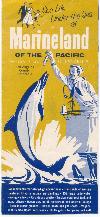 |
| 1954 Visitor Brochure, Marineland California |
|
|
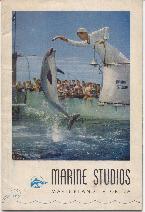 |
| 1951 Marine Studios Visitor Booklet, Marineland Florida |
|
|
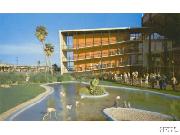 |
| World's First Wheelchair Ramps |
|
According to the 1954 Visitor Booklet...Marineland of the Pacific is modeled after the famous Marine Studios at Marineland, Florida, below St. Augustine. The two organizations are separate and distinct, but they have an agreement whereby scientific and technical information is exchanged. Marine Studios opened in 1938, and was the world's first "oceanarium". According to Marine Studios, an "oceanarium" differs from an "aquarium" on account that the collection on view is not segregated by species, but placed together as it exists in the open sea. Marine Studios later became known as Marineland of Florida, and comprised two main tanks. One is circular, 75 feet in diameter and 12 feet deep. The other is a rectangular tank, 100 feet long, 40 feet wide, and 18 feet deep. A "flume" or receiving tank connects the two. Pictures below show the similar architectural designs of the two main buildings, both taken in the early 1950's. Pereira & Luckman, the Los Angeles architectural firm that "redesigned" Marineland of the Pacific from the Florida design, was faced with a unique challenge. Oceanarium, Inc. (Marineland of the Pacific's newly-formed parent company) directed Pereira and Luckman to create the world's largest oceanarium by expanding on Florida's original design. The most logical approach would be for P&L to expand the original design by increasing the capacity of both the circular and oval tanks. Marineland of the Pacific's circular tank was increased to 80 feet in diameter, and 22 feet deep. The oval tank's 100 foot length was kept, but increased to 50 feet in width, and 22 feet in depth. Due to this volume of water and the weight associated with it, the main building was secured with five 4-level ramps, in what essentially amounted to "flying buttresses" to accomodate and redistribute the load coming from the main building. The ramps also served to easily move the thousands of visitors to each level, and avoid the challenges of stairs. In many ways, Pereira and Luckman could be said to be the true pioneers of the first wheelchair ramps; a true ADA accommodation nearly 40 years ahead of its time! |
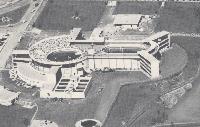 |
| Marineland of the Pacific |
|
|
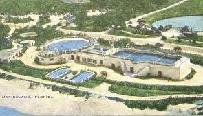 |
| Marineland of Florida |
|
|
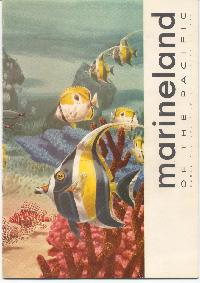 |
| 1954 and 1955 Visitor Booklet |
|
|
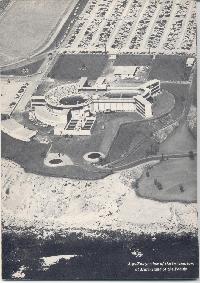 |
| 1954 and 1955 Inside Front Cover |
|
|
| First Visitor Booklets - 1954 and 1955 The 1954 booklet was introduced in the late Fall of that year. Comprising predominately of artists' renderings and pre-opening black and white construction photos of the park, a few black and white photos are also included of visitors taken on opening weekend in August. The cover of this 20-page booklet was carried over from the cover design of the 2-page commemorative booklet given to invited guests on Opening Day. The new exhibits are described in detail, and artists' renderings illustrate the variety of animals in the collection. The circular tank is further described with a 1500 seat amphitheater on the fourth top level affords a "front seat" for all spectators to witness the thrilling and amusing performances of the porpoises who are the principal inhabitants. [The world's first whale capture, Bubbles the Pilot Whale, would not occur for another three years.] The oval tank is described as being maintained at 70 degrees throughout the year to suit fish and sea life that would normally migrate seeking that temperature. All of these varieties are fed under water by divers in regulation gear who go below the surface several times daily with a basket of choice chopped squid...a delicious morsel enjoyed at all times by the myriad fishes in this man-made "ocean". The booklet was reissued in 1955 virtually unchanged except for a modification of the last paragraph on the first page that encourages: Visitors to Marineland find a "new show" each time they come. And the same is true in the physical makeup of the Oceanarium and its grounds, for a master plan calls for construction of more display pools, marinas and other interesting developments continuously in the years ahead. The Historical Society is proud to embrace and carry forward the original mission that Marineland of the Pacific will never be finished, for while visitors will find it extremely interesting today, they will find it considerably more entertaining when they return on their next trip...only a website away! |
 |
| 1959 Visitor Booklet |
|
|
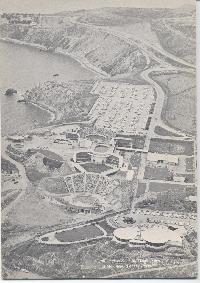 |
| 1959 Inside Front Cover |
|
|
|
The 1959 edition opens with a new aerial photo on the inside front cover. As you can see when comparing it to the 1954/55 aerial photo, considerable construction has been performed. The most noticable improvement has been the addition of the Sea Arena; "...an aquatic amphitheater housing the amazing educated porpoises and the riotously funny sea lions in watery apartments around a 500,000 gallon tank, which is the third of the three-rings in the Sea Circus. The Sea Arena opened in July of 1958, seats 3,000 persons and has a stage as big as the one in the famed Hollywood Bowl." If you look at the aerial photo again, you'll see on the left side (facing west) what appears to be a small amphitheater near the cliff. This was originally the small holding pool for sea lions when the park was first opened. Harold Winston was the trainer for the sea lions in the early days, and being the consummate showman that he was, he continued to impove his interaction with the public while they stood by and watched his daily feedings. Management quickly recognized the value he was bringing to these feedings, and slowly improved the holding tank to include a formal stage, stadium seating and a place on the park's show schedule. |
|
The sea lion "show" moved to the new Sea Arena, and was now commanded by "Captain" Harold Winston. The porpoises and dolphins also moved to the Sea Arena from the large circular tank of the main building. This was necessary on account of the need to move two new pilot whales that were currently residing in a small holding tank on the west side of the main buidling. "Bubbles" and "Squirt", two female, short-finned pilot whales, were transferred to the circular tank after July, 1958. "Bimbo", a large male, short-finned pilot whale, was added to the circular tank in 1959. Four white-sided dolphins also lived with the three whales and all animals were integrated into a brand new show. |
|
Marineland of the Pacific became extremely popular amongst the Hollywood set; so much so that a "Celebrity Board" was included in the main building that displayed photographs of dozens of Hollywood's top stars shaking hands with Bubbles the Whale or feeding the underwater "actors." The size of the tanks, volumes of water and good accessibility for cameras, made for a great partnership with Hollywood. Many films and television shows took full advantage of this, and celebrities were, at times, as visible to the public as the very animals showcased daily. |
 |
| 1962 Visitor Booklet |
|
|
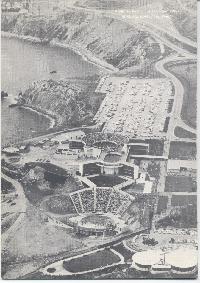 |
| 1962 Inside Front Cover |
|
|
| Additional Visitor Booklets Text will be added shortly; we thank you for your patience. |
 |
| 1964 Visitor Booklet |
|
|
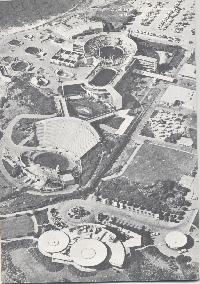 |
| 1964 Inside Front Cover |
|
|
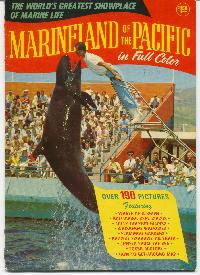 |
| 1966 Visitor Booklet |
|
|
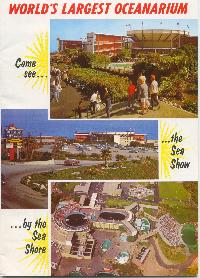 |
| 1966 Page 1 |
|
|
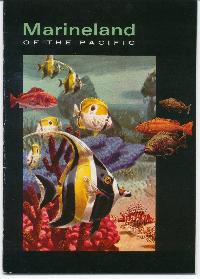 |
| 1969 Visitor Booklet |
|
|
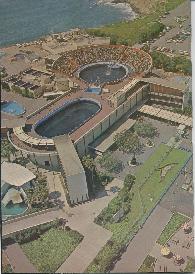 |
| 1969 Inside Front Cover |
|
|
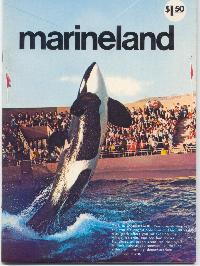 |
| 1973 Visitor Booklet |
|
|
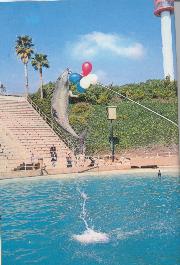 |
| 1973 Page 6 |
|
|
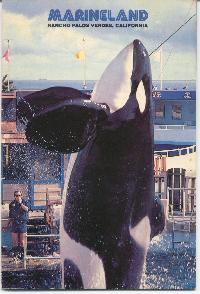 |
| 1984 Visitor Booklet |
|
|
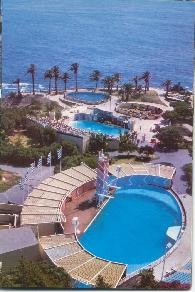 |
| 1984 Visitor Booklet, Page 19 |
|
|
|